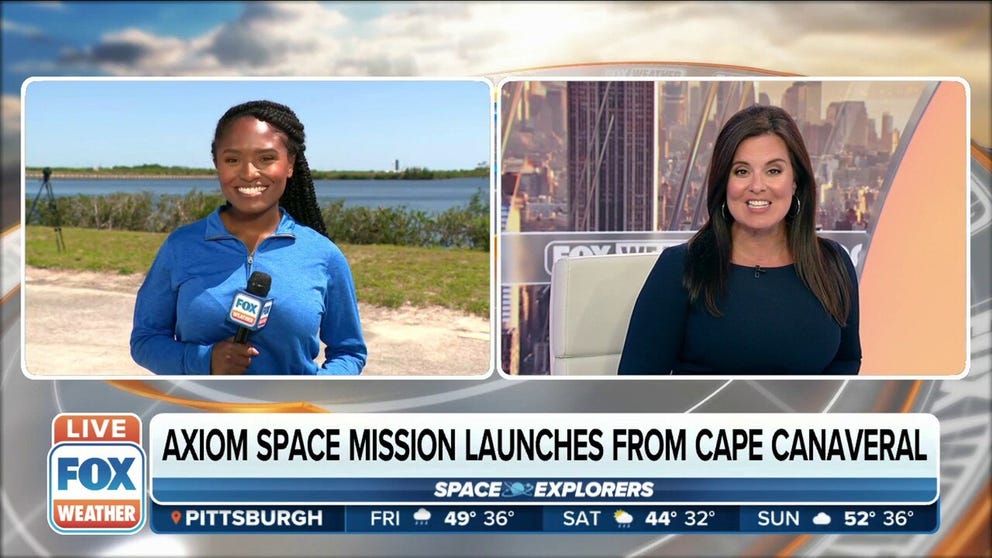First private astronaut mission blasts off from Florida beginning new era in spaceflight
American, Canadian and Israeli crew launch to ISS on first private astronaut mission
Axiom space mission launches from Cape Canaveral
Four private citizens became the first private astronauts tp mission to the ISS on Friday at 11:17 a.m. when SpaceX launched the crew on the Axiom mission-1.
KENNEDY SPACE CENTER, Fla. – For the first time, a SpaceX rocket with an international crew of non-government astronauts launched Friday from Florida, marking a new era in private spaceflight, one in which people pay to go to space instead of being paid to live there.
At 11:17 a.m. ET, the Falcon 9 Merlin engines carried the rocket and Dragon away from Kennedy Space Center launchpad 39A into a clear blue sky.
The newest Dragon riders are not paid astronauts but three wealthy investors who each paid $55 million for the ride of a lifetime. The Axiom Mission-1 crew consists of American Larry Connor, Canadian Mark Pathy, Israeli Eytan Stibbe and Axiom Space vice president and former NASA astronaut Michael López-Alegría, who is serving as mission commander.
CHEF JOSÉ ANDRÉS IS SENDING A FAMILY MEAL OF PAELLA TO SPACE WITH AXIOM-1 CREW
Axiom Space purchased a roundtrip ride on the SpaceX Dragon Endeavour to the International Space Station for its three paying customers. The launch marked the first of many as Axiom also has another private human spaceflight planned and is working on more.
Retired NASA Astronaut Peggy Whitson is the director of human spaceflight at Axiom Space. She will be the mission commander on the next Axiom Space mission, Ax-2.
"It's a very exciting stage for commercial spaceflight because it's kind of a stepping stone to where we've been," Whitson told FOX Weather. "We're increasing the time in space but also increasing the complexity of the operations there. And so this private mission is demonstrating our capabilities in that area and, because of that, it's a very exciting for me to be a part of this because it's the next logical step for space exploration."
MEET THE MEN BEHIND THE ALL-PRIVATE MISSION TO THE ISS
Whitson, who trained for years before her first spaceflight, said compared to space shuttle missions, the Axiom-1 crew had a finite amount of training for their 10-day mission. Whitson said López-Alegría and Connor received more training as pilot and commander.
"So it varies depending on the roles you're playing. But in that way, it is very similar to what we train for NASA missions in the past," Whitson said. "It's a little more condensed because it takes time to do all of that. So our crew members each have around a thousand hours or more of training in preparation for this flight, so it's a pretty significant amount of time and dedication that was required to get them through this level of training."
The Houston-based company plans to launch new space station modules in the coming years that will eventually separate, becoming the first private space station in low-Earth orbit. The first module launches in 2024.
While the space station has had private visitors before, this is the first time an entire crew consisting of paying visitors will stay for over a week. The Axiom-1 team will spend eight days living and working on the space station. Each private astronaut has selected science research to conduct in the low-gravity environment.
Axiom Space Operations Director Derek Hassmann said the four visitors understand the implications of their trip.
"They want to be the best possible private astronauts that you can imagine, and they've trained in that way. They're very well-prepared," Hassmann said. "They understand where they fit in the big scheme of things. They want to be good house guests."
Ahead of the launch, Connor, a businessman from Dayton, Ohio, said even with the busy schedule in space he will make time to enjoy the view.
"I suspect if you asked me post splashdown one of the highlights, it's going to absolutely be the view from 250 miles above Earth," said Connor.
About 20 minutes after liftoff, the Axiom 1 crew felt zero gravity.
"It's great to be here! Zero-G and we feel fine," López-Alegría told SpaceX mission control.
Dragon Endeavour is scheduled to dock at the ISS at 7:45 a.m. Saturday where they will be welcomed by the American and European astronauts already on board.





